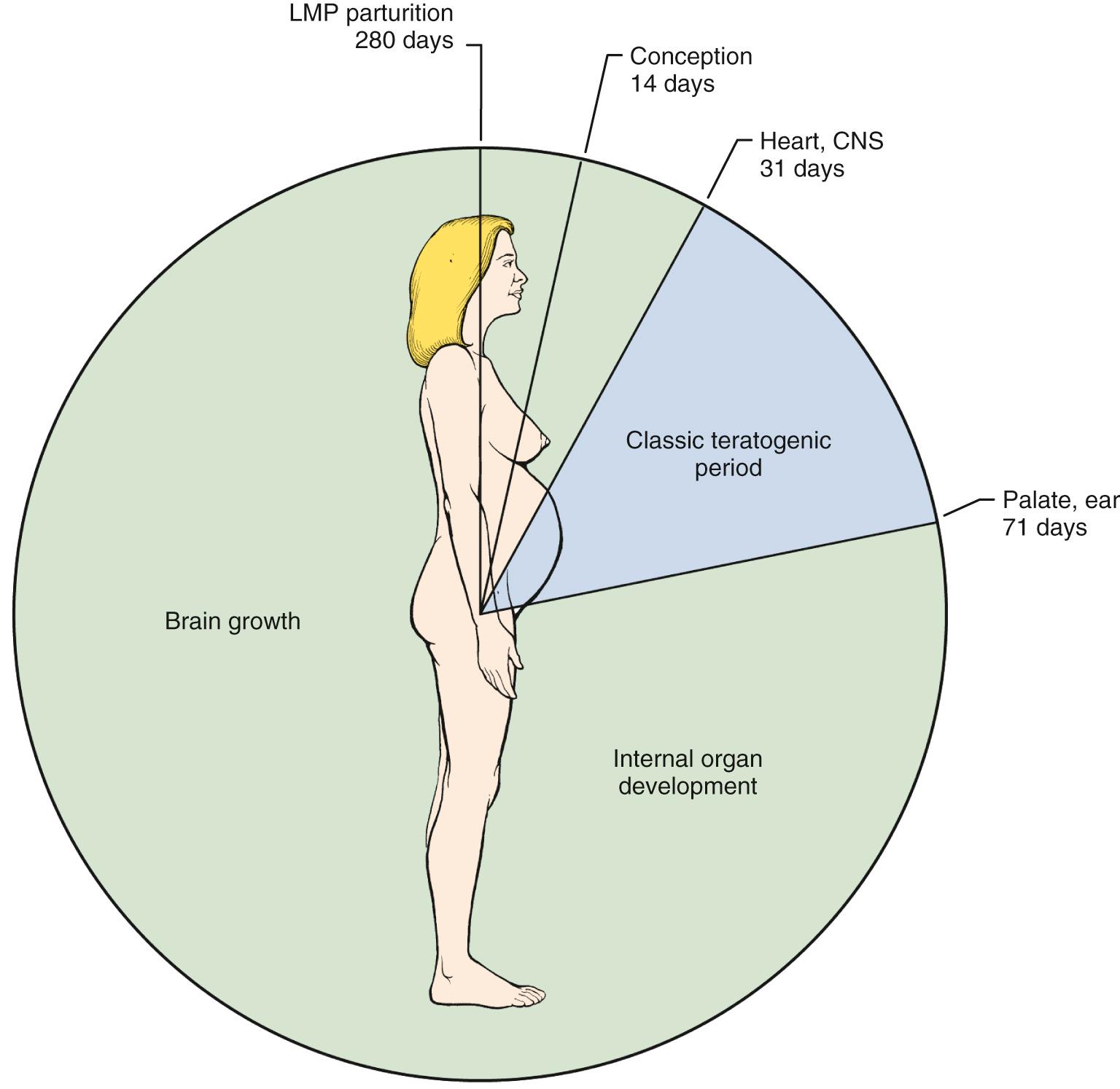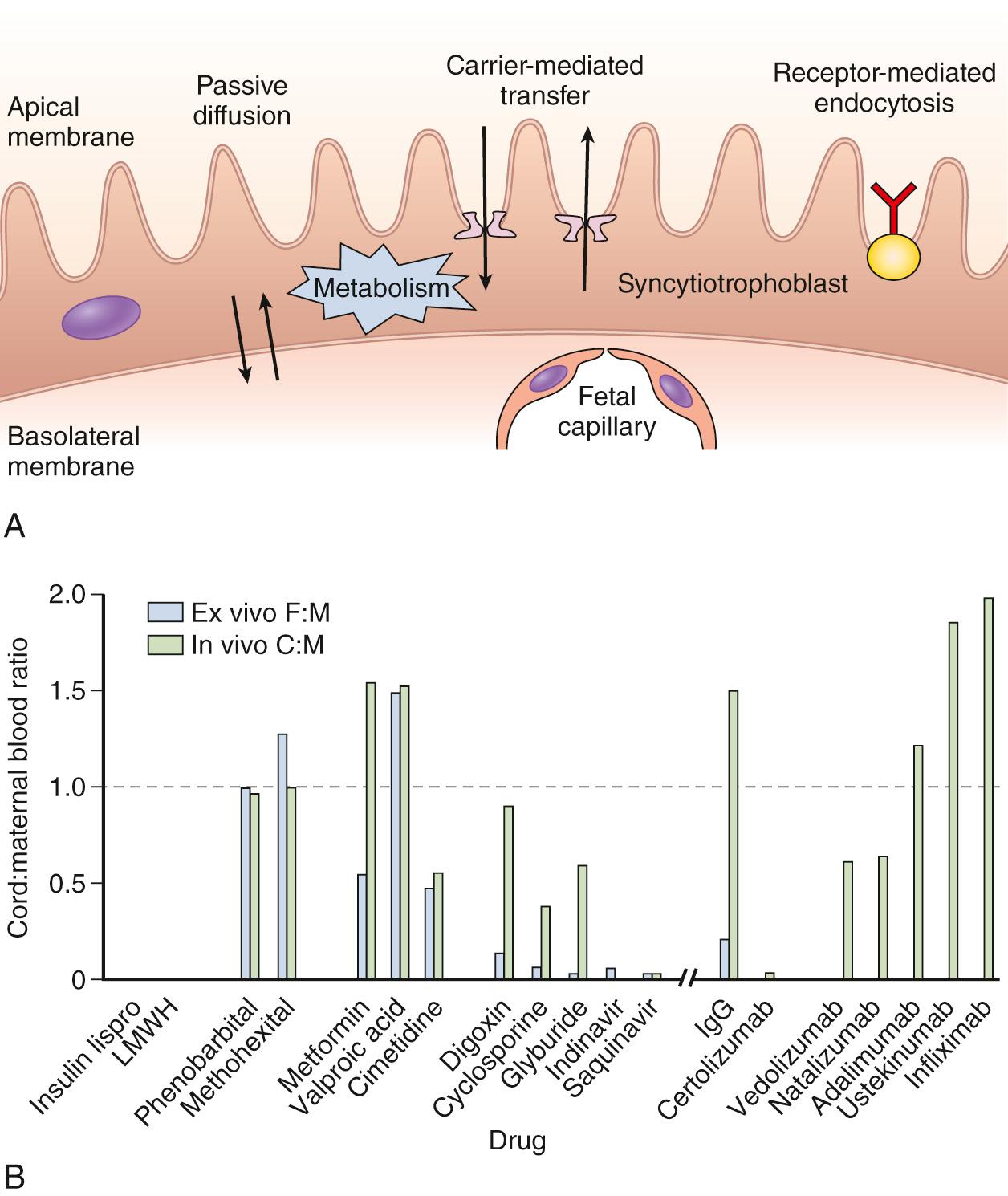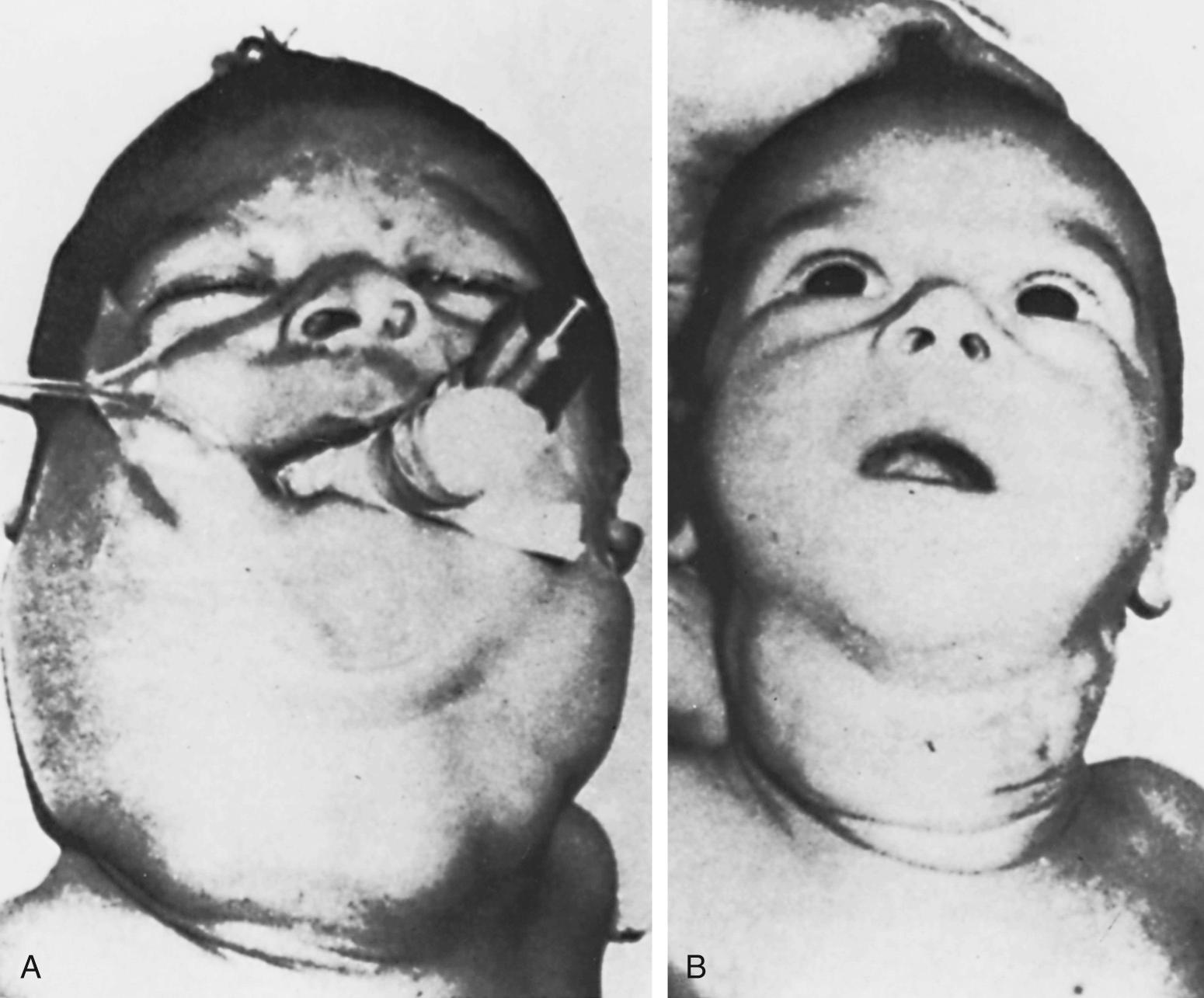Physical Address
304 North Cardinal St.
Dorchester Center, MA 02124
| Angiotensin-converting enzyme | ACE |
| Antiepileptic drug | AED |
| Birth defect monitoring system | BDMS |
| Dalton | Da |
| Diethylstilbestrol | DES |
| Electroencephalogram | EEG |
| Fetal alcohol syndrome | FAS |
| Food and Drug Administration | FDA |
| Glucose-6-phosphate dehydrogenase | G6PD |
| Low-molecular-weight heparin | LMWH |
| Maternal outcomes and neurodevelopmental effects of antiepileptic drugs | MONEAD |
| Neural tube defect | NTD |
| Over the counter | OTC |
| Propylthiouracil | PTU |
| Saturated solution of potassium iodide | SSKI |
| Sudden infant death syndrome | SIDS |
| Thyroid-stimulating hormone | TSH |
| Tumor necrosis factor | TNF |
| Unfractionated heparin | UFH |
| Zidovudine | ZDV |
Practicing obstetricians routinely address patient concerns and questions about the effects of using drugs during pregnancy and lactation or exposure to various environmental agents on their developing babies. This chapter provides some practical advice and direction for advising patients on the risks to the fetus from taking various prescription medicines and from being exposed to environmental toxins and illicit drugs. A basic understanding of drug pharmacology and the pharmacokinetics of drug passage across the placenta and into breast milk will help the practicing obstetrician provide the safest and soundest advice to patients.
The risks of drug exposure to the fetus must first be measured in terms of the overall rates of malformations. The incidence of major malformations in the general population is 2% to 3%. These malformations include those incompatible with survival (e.g., anencephaly) as well as those requiring major surgery (e.g., cleft palate or congenital heart disease) or causing permanent disability or developmental delays. The malformation rate may be as high as 7% to 10% if minor defects are counted (ear tags, extra digits). The teratology data from animal studies may not be accurate, as animal studies estimate risk with a 24% malformation rate. For example, thalidomide was not found to be teratogenic in rats and mice but is a potent human teratogen.
The US Food and Drug Administration (FDA) no longer uses lettered risk factors for teratogenicity (Federal Register. Content and format of labeling for human prescription drug and biologic products; requirement for pregnancy and lactation labeling. December 4, 2014). In fact, the Teratology Society had suggested eliminating the FDA letter classification more than 20 years ago. The FDA Pregnancy Risk Categorization by Trimester List names the risks from categories A to X. These categories were designed for prescribing physicians and not to address inadvertent exposure. For example, isotretinoin (Accutane) and oral contraceptives are both category X, based on lack of benefit for oral contraceptives during pregnancy, yet oral contraceptives do not have any teratogenic risk with inadvertent exposure. However, the drugs in different categories may pose similar risks but be in different categories based on risk/benefit considerations. Second, the categories create the impression that drugs within a category present similar risks, whereas the category definition permits inclusion in the same category of drugs that vary in type, degree, or extent of risk, depending on potential benefit. For these reasons, this chapter does not use category designations but simply lists the risks of a drug's use in pregnancy and refers to specific descriptions in teratogen information databases ( Fig. 7.1 ). However, as a quick guide for clinicians, some selected medications on the FDA's Pregnancy Risk Categorization by Trimester List rated as Category X (contraindicated in pregnancy) are included ( Box 7.1 ). This list, though not all-inclusive, adds or supports much of the information in this chapter.

Hydroxyzine (early pregnancy)
Aspirin (third trimester)
Warfarin
“Statin” drugs (e.g., rosuvastatin, atorvastatin)
Flurazepam
Triazolam
Temazepam
Isotretinoin
Fluorouracil (topical)
Finasteride (avoid handling capsules in pregnancy)
Silver sulfadiazine (topical; late pregnancy)
Testosterone and derivatives
Leuprolide
Misoprostol
Ribavirin
NSAIDs (e.g., naproxen, piroxicam, meloxicam) (third trimester)
Celecoxib (third trimester)
Dantrolene
Methotrexate
Raloxifene
Dutasteride (avoid handling capsules in pregnancy)
NSAIDs , Nonsteroidal antiinflammatory drugs.
The classic teratogenic period is from day 31 after the last menstrual period in a 28-day cycle to 71 days from the last period (see Fig. 7.1 ). During this critical period, organs are forming and teratogens may cause malformations that are usually overt at birth. Administration of drugs early in this period may affect the heart or neural tube; later exposure affects the formation of the ear and palate. Before day 31, exposure to a teratogen produces an all-or-none effect, resulting in either death of the conceptus or survival with no anomalies. Many parameters can influence the transfer of drugs from the maternal to the fetal circulation and then affect the impact of each individual drug on fetal development. The most of important of these factors are gestational age, the structure of the drug molecule, and the pattern of drug usage (sporadic or chronic). Additional or concomitant factors include interaction between drugs in multitherapy; individual maternal metabolism, which may be genetically driven; maternal disorders such as liver or kidney disease; and integrity of the placental structure, which may be altered by smoking and other substance abuse.
To understand the etiology of birth defects, Wilson's six general principles of teratogenesis provide a framework for understanding how structural or functional teratogens may act.
The first principle is that susceptibility to a teratogen depends on the genotype of the conceptus and the manner in which the genetic makeup of the conceptus interacts with environmental factors. For example, different genetic strains of mice vary greatly in their susceptibility to teratogens that lead to oral clefts. Some of the variability in responses to antiepileptic drugs (AEDs), like valproic acid and phenytoin, probably relates to the genotype of the embryo.
Wilson's second principle is that susceptibility of the conceptus to teratogenic agents varies with the developmental stage at the time of exposure. This concept of critical stages of development directly affects alterations in structure. It is during the second to eighth week of development after conception—the embryonic period—that most structural defects occur. For example, neural tube defects (NTDs) may result from exposure between 22 and 28 days postconception. Thalidomide teratogenicity differs as a function of the developmental stage at exposure.
The third principle is that teratogenic agents act in specific ways ( mechanisms ) on developing cells and tissues in initiating abnormal embryogenesis (pathogenesis). Teratogenic mechanisms are considered separately further on.
The fourth principle is that irrespective of the specific deleterious agent, the final manifestations of abnormal development are death, malformation, growth restriction, and/or functional disorder. The manifestation is thought to depend largely on the stage of development at which exposure occurs; a teratogen may have one effect if exposure occurs during embryogenesis (structural abnormalities or death) and another if the exposure is during the fetal period (functional deficits).
The fifth principle is that access of adverse environmental influences to developing tissues depends on the nature of the influence ( agent ). This principle relates to such pharmacologic factors as maternal metabolism and placental passage. For an adverse effect to occur, an agent must reach the conceptus, either transmitted indirectly through maternal tissues or directly by traversing the maternal body.
Wilson's final principle is that manifestations of abnormal development increase in degree from the no-effect level to the lethal level as dosage increases. This means that the response (e.g., malformation, growth restriction) varies according to the dose, duration, or amount of exposure. For most human teratogens, this dose-response is not clearly understood, but along with the principle of critical stages of development, these concepts are important in supporting causal inferences about human reproductive hazards. In utero exposure to ionizing radiation clearly shows the importance of dose on teratogenic effect.
Various studies can determine the risks of drugs and environmental agents on the fetus, from single case reports to larger clinical trials, all with varying degrees of strength of evidence.
Many known teratogens and reproductive toxicants were identified initially through single case reports. Published observations of abnormal aggregations of cases or patterns of malformations are important; however, these observations are not reliable in identifying the true risk posed by various drugs and environmental agents.
Descriptive epidemiologic studies provide information about the distribution and frequency of a given clinical outcome, resulting in comparable rates of occurrence. Descriptive studies first begin by describing a risk population and using that population as a denominator for calculating an outcome rate. Second, a numerator is defined as the outcome, validated by some specific method (case definition and ascertainment).
Surveillance programs are considered descriptive studies where an at-risk population is identified and then followed over time to detect outcomes of interest. Birth defect monitoring systems (BDMSs) are designed to identify cases occurring in a defined population, usually by reviewing vital records or hospital record abstracts or charts. BDMSs have grown in the last 20 years. However, despite increased surveillance and reporting, the true risk of exposure to drugs and environmental agents cannot be determined. One of the main issues in studying the impact of a specific drug on the fetus (e.g., in the case of commonly used drugs such as paracetamol or aspirin but also of maternal exposure to nicotine and caffeine) is that such exposures can never be excluded as confounding factors and are difficult to quantify. Descriptive studies should be employed initially, followed by case-control studies as listed further on. For example, after suspecting, on the basis of case observations, that thalidomide was teratogenic, Lenz conducted a case-control study. Also, the association between the use of valproic acid and the occurrence of spina bifida was verified by case-control studies.
The most widely used approach in determining teratogenicity is the case-control study, where groups of individuals with some outcome or disease of interest (cases) (e.g., a congenital malformation) are compared with similar groups. After cases and controls have been identified, the hypothesis to be tested is whether these two groups differ in exposure as well as outcome. How accurately exposure and its timing are determined may vary greatly among studies, but in any study the same methods must be used to establish the exposure of both cases and controls. Case-control studies may have implicit bias in selecting controls and other variables.
Cohort studies, often called prospective studies, require that groups differing in exposure be followed through time, with outcomes observed. Therefore these studies tend to be time-consuming and expensive. In addition, occurrence rates for many adverse reproductive outcomes, such as congenital malformations, are low; thus, large samples must be followed for a considerable period of time. Cohort studies enable investigators to calculate incidence rates, which provide a measure of relative risk of an outcome after the exposure. Historical prospective studies identify groups that have been exposed and follow their outcomes in a retrospective manner.
Ideally, analytical studies (case-control or cohort) are followed by a randomized clinical trial, in which the efficiency of a prevention or treatment regimen is evaluated. That is, subjects are randomly assigned to different treatment groups. Clinical trials of both NTD recurrence and occurrence showed the importance of folic acid supplementation in pregnancy.
The permeability of the placenta is well known, dating back to around 1904; however, in the 1960s, the placenta was erroneously thought to be an effective barrier to harmful substances. That misconception resulted in serious birth defects from the prescription of thalidomide, benzodiazepines, and other toxic medications. Similarly, drug transfer to the newborn via maternal breast milk have been studied only recently and the corresponding data are limited. An understanding of the ways in which different drugs cross the placenta or into the breast milk is essential to the practicing obstetrician in assessing medication use in the pregnant and breastfeeding patient.
To reach the fetal tissues and organs, the molecules that have entered the placenta via the maternal circulation have to first cross the placental barrier. The placental villous barrier or membrane is made up of the trophoblast, which covers the villous tissue externally and is in direct contact with the maternal blood in the intervillous space, the villous mesenchymal tissue, and the endothelium of the fetal capillaries (see Chapter 1 ).
Important anatomic changes take place between the first and second trimesters of pregnancy. During most of the first trimester, the entire gestational sac is covered with villous tissue and the entry of maternal blood inside the placenta is limited by the presence of trophoblastic plugs blocking the mouths of the uteroplacental arteries in the area destined to become the definitive placenta. On the fetal side, the villous capillaries are small in numbers and size and located more centrally inside the villi at a much greater distance from the trophoblastic layer than later in pregnancy. During that period of gestation, the placental transfer route is described as histiotrophic via the uterine glands, extraembyonic coelom, and the secondary yolk sac. The placenta becomes truly hemochorial only from the end of the first trimester. The villous membrane becomes progressively thinner, facilitating maternal-fetal exchanges in both directions with advancing gestation.
For the most part, placental drug transfers have been studied using animal models, essentially rodents, or in vitro using third-trimester ex vivo isolated dual-side perfused human cotyledons. Both models have obvious limitations, in particular, regarding transfers during the first trimester of human pregnancy, which is the gestational period when the human fetus is at highest risk for teratogenic effects. Placental drug pharmacokinetics can be indirectly studied in vivo using coelocentesis (the aspiration of coelomic fluid) in the first trimester or cord blood samples at delivery.
Overall, it is assumed that all drugs will in some manner cross into the placenta, especially those that are lipid soluble; water-soluble drugs and metabolites of drugs pass less readily. Only free drug will pass into the placenta, so any portion of drug bound by protein will not cross the placenta. Substances cross mainly from the maternal to the fetal circulation by passive diffusion ( Fig. 7.2 ). Thus passive diffusion across the villous barrier is the predominant method of the fetus's exposure to drugs and environmental agents, with low-molecular-weight lipid-soluble substances and non-protein-bound drugs passing easily. Compounds greater than 600 Da—such as insulin, heparin, or drugs bound by proteins—do not pass easily into the placenta. Drug concentrations in the fetus may exceed maternal concentrations, with weakly basic drugs passing more easily. Passive drug transfer is flow dependent and membrane limited. As the flow volume in the placental circulations increases and the thickness of the villous barrier decreases, respectively, with advancing gestation, fetal exposure to drugs and environmental agents is greatest in the last trimester but the effect on fetal organs is the lowest.

Several drug transport systems have been found at the villous membrane level. The placenta expresses enzymes that facilitate the metabolism of various substances, including drugs. There are various cytochrome P450 enzymes that result in phase I and II reactions in the placental tissues. Phase I reactions include oxidation, reduction, and hydrolysis, whereas phase II reactions include conjugation. The metabolism of drugs in the placenta results in water-soluble substances, those that do not pass easily into the placenta; however, there may be a risk of toxic metabolites and exposure to the fetus. Drugs that have been shown to experience significant placental metabolism include zidovudine, dideoxynosine, and oxcarbazepine. The metabolism of oxcarbazepine may explain the limited data showing it to be safe to use during pregnancy.
Awareness of the pharmacokinetics may affect fetal exposure to drugs or environmental agents. The rate and extent of drug distribution across the placenta predict the fetal exposure to a drug. Drugs administered rapidly as a single dose may not accumulate in the fetus, since the drug concentration declines significantly before crossing the placenta. Drugs given on a continuous basis will accumulate more significantly in the placenta and cross into the fetus. For example, valproic acid crosses the placenta readily and equilibrates in the fetal plasma within 1.5 hours ; a prolonged-release formulation of valproic acid is recommended to prevent high fetal concentrations of this drug. Other research to minimize (or enhance) the placental transfer of drugs includes developing nanoparticles of drugs. Currently there are two ongoing trials to evaluate this drug delivery system in pregnant women.
Pharmacokinetic data on drug administration during lactation are limited and often inconsistent. Many drugs can be detected in breast milk at low levels that are not usually of clinical significance to the infant. The rate of transfer into milk depends on the drug's lipid solubility, molecular weight, and degree of protein binding, its degree of ionization, and the presence or absence of active secretion. Nonionized molecules of low molecular weight, such as ethanol/alcohol, cross easily. If the mother has unusually high blood concentrations as with increased dosage or decreased renal function, drugs may appear in higher concentrations in the milk.
The amount of drug in breast milk is a variable fraction of the maternal blood level, which itself is proportional to the maternal oral dose. Thus the dose to the infant is usually subtherapeutic, approximately 1% to 2% of the maternal dose on the average. This amount is usually so trivial that no adverse effects are noted. In the case of toxic drugs, however, any exposure may be inappropriate. Allergy may also exist or be initiated. Long-term effects of even small doses of drugs are yet be investigated. Also, drugs are eliminated more slowly in the infant with immature enzyme systems. Short-term effects of most maternal medications on breastfed infants are mild and pose little risk. As the benefits of breastfeeding are well known, the risk of drug exposure must be weighed against these benefits.
With drug administration in the immediate few days postpartum, before lactation is fully established, the infant receives only a small volume of colostrum. Thus little drug is excreted into the milk. It is also helpful to allay the fears of undergoing cesarean deliveries regarding analgesics or other drugs administered at this time, assuring them that such drugs have no known adverse effects on the infant. For drugs requiring daily dosing during lactation, knowledge of pharmacokinetics in breast milk may minimize the dose to the infant. For example, dosing immediately after nursing decreases the neonatal exposure because the blood level will be at its nadir just before the next dose.
The metabolism of drugs affects the amount of medication in the breast milk. A classic case is the use of codeine during lactation; mothers who receive codeine and are “ultrarapid” metabolizers will convert codeine to high concentrations of morphine, which easily passes into the breast milk. Cases of respiratory depression and other serious consequences in the baby have been reported in rapid metabolizing breastfeeding mothers who have received codeine. In addition, there is a risk of accumulation of the active metabolite of tramadol (O-desmethyltramadol, or M1) in ultrarapid metabolizers, causing serious effects in the baby.
Patient assessment and education regarding drugs and pregnancy are covered briefly at the end of this chapter. Generally the risks versus benefits of using drugs in pregnancy should be carefully weighed, with the goal of minimizing the use of over-the-counter (OTC) and prescription drugs. Patients should be encouraged to use nonpharmacologic means of managing common pregnancy symptoms such as headaches, muscle pains, nausea and vomiting, and so on. Some drugs may also interact with the results of screening tests for conditions such as aneuploidy and NTDs. For example, methadone has been reported to cause false-positive tests for trisomy 18, and false-positive rates for NTDs were higher for those on corticosteroids, antibiotics, and antidepressants.
Studies have not confirmed any teratogenic risk from the use of oral contraceptives or progestin. A meta-analysis of first-trimester sex hormone exposure revealed no association between exposure and fetal genital malformations.
A ndrogens may masculinize a developing female fetus. Danazol (Danocrine) has been reported in 23 of 57 female infants exposed to produce clitoral enlargement and labial fusion when given inadvertently for the first 9 to 12 weeks after conception ( Fig. 7.3 ).

A meta-analysis of reports of spermicide exposure concludes that there is no increased risk of birth defects.
Continuing AED therapy in pregnancy depends on seizure control prior to conception and understanding the ability to provide seizure control on a regimen adjusted for pregnancy. Most experts agree that the benefits of AEDs in appropriates doses during pregnancy outweigh the risks of discontinuation. Continuing AEDs also depends on the type of seizures, seizure control, adverse effects of the AED regimen, and patient adherence (determined by serum measurement of the AED). Poor adherence in the absence of seizures may not warrant AED therapy during pregnancy. Also, women who are seizure-free for at least 2 years as confirmed by electroencephalography (EEG) should consider stopping AED therapy during pregnancy.
The MONEAD monitored the prescribing of AEDs over a 4-year period and shows a changing pattern of AED prescribing. From 2012 to 2016, the most common medications used in pregnancy and epilepsy were lamotrigine, leviteracetam, carbamazepine, and zonisamide, respectively; this compares with the most common therapies prescribed from 1999 to 2004, which were carbamazepine, lamotrigine, phenytoin, and valproate. Given the fetal risks associated with valproate and phenytoin, one could assume that possible fetal risk may be reduced by the changing patterns of AED prescribing to less teratogenic AEDs.
Women with epilepsy taking AEDs during pregnancy have nearly double the risk of malformations (5%) compared with pregnant women without epilepsy (2% to 3%). The major malformations include cleft lip (with or without cleft palate) and congenital heart disease. Importantly, valproic acid (Depakene and its various generic formulations) and carbamazepine (Tegretol and its various generic formulations) each carry approximately a 1% risk of NTDs and other anomalies. Valproic acid monotherapy significantly increases the risk for spina bifida (odds ratio [OR], 12.7), atrial septal defect (OR, 2.5), cleft palate (OR, 5.2), hypospadias (OR, 4.8), polydactyly (OR, 2.2), and craniosynostosis (OR, 6.8). A high daily dose or a combination of two or three of these drugs increases the chance of malformations. Most pregnancy and AED data registries note that the highest risk of malformations is associated with valproate. In addition, exposure to more than one AED increases the risk of a malformation.
Phenytoin (Dilantin) decreases folic acid levels, thus increasing the risk of birth defects. Therefore folic acid supplementation should be given to these mothers, but this may require adjustment of the AED. Although women with epilepsy were not included in the Medical Research Council study, most authorities would recommend 4 mg/d of folic acid for high-risk women. One study suggested that folic acid at doses of 2.5 to 5 mg daily could reduce birth defects in women on AEDs.
Fewer than 10% of offspring show the fetal hydantoin syndrome, which consists of microcephaly, growth deficiency, developmental delays, mental retardation, and dysmorphic craniofacial features ( Fig. 7.4 ). In fact, the risk may be as low as 1% to 2%. Although several of these features are also found in other syndromes, such as fetal alcohol syndrome (FAS), more common in the fetal hydantoin syndrome are hypoplasia of the nails and distal phalanges ( Fig. 7.5 ) and hypertelorism. Carbamazepine (Tegretol and its various generic formulations) is also associated with an increased risk of a dysmorphic syndrome. A genetically determined metabolic defect in arene oxide detoxification in the infant may increase the risk of a major birth defect. Epoxide hydrolase deficiency may indicate susceptibility to fetal hydantoin syndrome. Lamotrigine exposures have been compiled in a voluntary registry established by the manufacturer, GlaxoSmithKline. After 1558 exposures in the first trimester, no increased risk of birth defects overall has been observed. Of 1532 infant exposures to newer-generation AEDs, 1019 were to lamotrigine, and 3.7% involved major birth defects. In 393 infants exposed to oxcarbazepine, the rate was 2.8%, and in 108 exposed to topiramate, the rate was 4.6%. None of these were statistically different from the rates found controls. Valproic acid carries significantly higher risks than lamotrigine or carbamazepine. One study suggested a fivefold increased risk of cleft lip and/or cleft palate with the use of topiramate.


Isotretinoin (Accutane and its various generic formulations) is a significant human teratogen. This drug is marketed for the treatment of cystic acne and unfortunately has been taken inadvertently by women who were not planning pregnancy. Long-acting reversible contraceptives such as an intrauterine device (IUD) or Nexplanon, another birth control implant, are recommended. Isotretinoin is contraindicated in pregnancy (FDA category X); pregnancy testing prior to the initiation of therapy is recommended. Of 154 exposed human pregnancies, the following have been reported: 21 cases of birth defects, 12 spontaneous abortions, 95 elective abortions, and the birth of 26 normal infants in women who took isotretinoin during early pregnancy. The risk of structural anomalies in patients studied prospectively is estimated at 25%. An additional 25% have developmental delays. The malformed infants have a characteristic pattern of craniofacial, cardiac, thymic, and central nervous system anomalies. They include microtia/anotia (small/absent ears) ( Fig. 7.6 ), micrognathia, cleft palate, heart defects, thymic defects, retinal or optic nerve anomalies, and central nervous system malformations including hydrocephalus. Microtia is rare as an isolated anomaly yet appears commonly as part of the retinoic acid embryopathy. Cardiovascular defects include transposition of the great vessels and ventricular septal defects. A pregnancy after discontinuing isotretinoin is not at risk, as the drug is no longer present in the serum after 5 days of discontinuation. Topical tretinoin (Retin-A) has not been associated with any teratogenic risk.

There is no evidence that vitamin A in the diet in in normal doses or beta carotene is teratogenic. Prenatal vitamins containing 5000 IU have not been associated with any documented risk. Eighteen cases of birth defects have been reported after exposure to levels of 25,000 IU of vitamin A or greater during pregnancy.
There is no clear documented risk for most psychoactive drugs with respect to overt birth defects. However, effects of chronic use of these agents on the developing brain in humans are difficult to study; therefore a conservative approach to prescribing these drugs is recommended, primarily weighing the benefits of treatment against the risks of untreated depression or other mental illnesses.
Fetal benzodiazepine syndrome has been reported in seven infants of 36 mothers who regularly took benzodiazepines during pregnancy; this number is complicated by cases where alcohol and substance abuse were also present. Generally the chronic use of benzodiazepines is not recommended in pregnancy.
In the International Register of Lithium Babies, 217 infants were listed as exposed at least during the first trimester of pregnancy, and 25 (11.5%) were malformed. Eighteen had cardiovascular anomalies, including six cases of the rare Ebstein anomaly, which occurs in only 1 in 20,000 in the nonexposed population. Of 60 unaffected infants who were followed to age 5 years, no increased mental or physical abnormalities were noted compared with unexposed siblings.
However, two other reports suggest bias of ascertainment in the registry and a risk of anomalies much lower than previously thought. A case-control study of 59 patients with the Ebstein anomaly showed no difference in the rate of lithium exposure in pregnancy from a control group of 168 children with neuroblastoma. A prospective study of 148 women exposed to lithium in the first trimester showed no difference in the incidence of major anomalies compared with controls. We recommend that women exposed to lithium be offered ultrasound and fetal echocardiography.
Lithium is excreted more rapidly during pregnancy; thus serum lithium levels should be monitored. Perinatal effects of lithium on the infant have been noted, including hypotonia, lethargy, and poor feeding. Also, complications similar to those seen in adults on lithium have been noted in newborns, including goiter and hypothyroidism. Two cases of polyhydramnios from lithium toxicity caused by fetal diabetes insipidus have been reported with maternal lithium treatment. Lithium therapy should be discontinued during pregnancy; however, close monitoring for relapsing manic and depressive symptoms and their complications (harm to self, others, substance abuse, etc.) may be required. These women should be offered appropriate prenatal diagnosis with ultrasound, including fetal echocardiography. Tapering over 10 days delays the risk of relapse. Lithium may be withheld for 24 to 48 hours before delivery to reduce both neonatal complications and infant hospital stays.
When the use of antidepressant drugs during pregnancy is being considered, it should be noted that among women who maintained their medication throughout pregnancy, 26% relapsed compared with 68% who discontinued their medication. Also, fetal alcohol spectrum disorders were 10 times more common in offspring who had been exposed to selective serotonin reuptake inhibitors (SSRIs) than those who had not been exposed. Counseling such as cognitive behavioral therapy may be as effective as drug therapy in the treatment of such women.
No increased risk of major malformations has been found after first-trimester exposure to fluoxetine (Prozac) in several studies. However, one recent study showed a twofold increased risk of ventricular septal defects. Chambers et al. found more minor malformations and perinatal complications among infants exposed to fluoxetine throughout pregnancy, but this study is difficult to interpret because the authors did not control for depression. One study suggested an increased risk of low-birthweight infants with higher doses of fluoxetine (40 to 80 mg) throughout pregnancy.
Nulman et al. have evaluated the neurobehavioral effects of long-term fluoxetine exposure during pregnancy and found no abnormalities among 228 children aged 16 to 86 months (average age, 3 years). Theoretically some psychiatric or neurobehavioral abnormality might occur as a result of exposure, but it would be very difficult to ascertain because of all of the confounding variables.
Current data on other SSRI exposures show no consistent teratogenic risk . Citalopram is transferred across the placenta the most, followed by fluoxetine. No major malformations have occurred in 133 infants exposed to bupropion (Zyban, Wellbutrin, and their various generic formulations). The lowest transfer is found with sertraline, followed by paroxetine. However, two studies found an increased risk of cardiac defects after exposure to paroxetine (Paxil). On the other hand, a recent large population-based cohort study suggested no substantial increased risk of cardiac defects attributable to antidepressant use in the first trimester. One study showed a twofold increased risk of NTDs after citalopram (Celexa). Finally, a large Nordic cohort showed no increased risk of stillbirth, neonatal mortality, or postnatal mortality from SSRI use in pregnancy.
Studies have described neonatal withdrawal in the first 2 days after in utero exposure to these drugs. Infants exposed during pregnancy exhibited more tremulousness and sleep changes at 1 to 2 days of age. However, no abnormalities were found when children were examined at age 16 to 86 months after prolonged exposure during pregnancy.
A sixfold increased risk of persistent pulmonary hypertension in the newborn has been reported in infants exposed to SSRIs after 20 weeks of pregnancy, raising the absolute risk from 1 to 2 per 1000 in unexposed infants to 6 to 12 per 1000 in exposed infants. Another study did not confirm this finding but confirmed a fivefold increased risk of persistent pulmonary hypertension with cesarean section before labor. Exposure to SSRIs in the first trimester did not increase the risk of miscarriage.
Anticoagulation for various thrombotic diseases is important to prevent new or recurrent embolization. Warfarin (Coumadin and various generic formulations) has been associated with chondrodysplasia punctata , which is similar to the genetically determined Conradi-Hünermann syndrome. Warfarin embryopathy occurs in about 5% of exposed pregnancies; it includes nasal hypoplasia, bone stippling seen on radiologic examination, ophthalmologic abnormalities including bilateral optic atrophy, and mental retardation ( Fig. 7.7 ). Ophthalmologic abnormalities and mental retardation may occur even with use only beyond the first trimester. The risk for pregnancy complications is higher when the mean daily dose of warfarin is more than 5 mg. If warfarin is prescribed, maintaining the consistency of drug formulation (e.g., not switching generic formulations or brands) minimizes the risks of adverse events.

The alternative drugs, heparin or enoxaparin, do not cross the placenta because their molecules are too large. Heparin is the drug of choice in anticoagulation therapy for pregnant women without heart valves who require anticoagulation. Patients receiving more than 20,000 U/day of heparin for long periods (>20 weeks) should be monitored for bone density reduction; high-dose heparin increases the risk of spinal fractures fourfold. Low-molecular-weight heparins (LMWHs) may have substantial benefits over standard unfractionated heparin (UFH). The molecules are still relatively large and do not cross the placenta. The half-life is longer, allowing for once-daily administration. However, enoxaparin (Lovenox) is cleared more rapidly during pregnancy; therefore twice-daily dosing is advised. LMWHs have a much more predictable dose-response relationship, thus obviating the need for monitoring partial thromboplastin time. There is less risk of heparin-induced thrombocytopenia and clinical bleeding at delivery, but studies suggesting less risk of osteoporosis are preliminary.
Women with mechanical heart valves, especially the first-generation valves, require warfarin anticoagulation or LMWH because heparin is not safe or effective. Heparin treatment is also associated with more thromboembolic complications and more bleeding complications than warfarin therapy. Evaluation of pooled incidences (95% confidence intervals) in a large meta-analysis comparing warfarin treatment, LMWH, and heparin, maternal mortality occurred in 0.9% (95% CI, 0.4–1.4), 2.0% (95% CI, 0.8–3.1), and 2.9% (95% CI, 0.2–5.7): thromboembolic complications in 2.7% (95% CI, 1.4–4.0), 5.8% (95% CI, 3.8–7.7), and 8.7% (95% CI, 3.9–13.4); live births in 64.5% (95% CI, 48.8–80.2), 79.9% (95% CI, 74.3–85.6), and 92.0% (95% CI, 86.1–98.0); anticoagulant-related fetal adverse events (embryopathy) occurred in 2.0% (95% CI, 0.3–3.7), 1.4% (95% CI, 0.3–2.5), and 0%, respectively. When UFH was used throughout pregnancy, 11.2% (95% CI, 2.8–19.6) of the women suffered thromboembolic complications. Stillbirth occurred with first-trimester warfarin doses equal to or greater than 5 mg/day, although there were more live births (83.6% [95% CI, 75.8–91.4] vs. 43.9% [95% CI, 32.8–55.0]) and fewer malformations (2.3% [95% CI, 0.7–4.0] vs. 12.4% [95% CI, 3.3–21.6]) with lower doses than with warfarin in doses greater than 5 mg/day.
Propylthiouracil (PTU) and methimazole (Tapazole) both cross the placenta and may cause some degree of fetal goiter. In contrast, the thyroid hormones triiodothyronine and thyroxine cross the placenta poorly, so that fetal hypothyroidism produced by antithyroid drugs cannot be corrected satisfactorily by administering thyroid hormone to the mother. Thus the goal of such therapy during pregnancy is to keep the mother slightly hyperthyroid to minimize fetal drug exposure. By the third trimester, 30% of women no longer need antithyroid medication.
Methimazole has been associated with scalp defects in infants and choanal or esophageal atresia as well as a higher incidence of maternal side effects. However, PTU and methimazole are equally effective and safe for the treatment of hyperthyroidism. In 2009 the FDA released a black box warning highlighting serious liver injury with PTU treatment, to a greater extent than methimazole. The Endocrine Society is now advocating treatment with PTU only during the first trimester and switching to methimazole for the remainder of the pregnancy.
Radioactive iodine ( 131 I or 125 I) administered for thyroid ablation or for diagnostic studies is not concentrated by the fetal thyroid until after 12 weeks of gestation. Thus, with inadvertent exposure before 12 weeks, there is no specific risk to the fetal thyroid from 131 I or 125 I administration.
The need for thyroxine increases in many women with primary hypothyroidism when they are pregnant, as reflected by an increase in serum thyroid-stimulating hormone (TSH) concentrations. Because hypothyroidism in pregnancy may adversely affect the fetus, possibly by increasing prematurity, it is prudent to monitor thyroid function throughout pregnancy and to adjust the thyroid dose to maintain a normal TSH level. It is recommended that women with hypothyroidism increase their levothyroxine dose by approximately 30% as soon as pregnancy is confirmed (two extra doses each week) and then have dosing adjustments based on TSH levels.
α methyldopa (Aldomet and various generic formulations) has been widely used for the treatment of chronic hypertension in pregnancy. Although postural hypotension may occur, no unusual fetal effects have been noted. Hydralazine (Apresoline) is used frequently in pregnancy and no teratogenic effect has been observed.
Propranolol (Inderal) is a β-adrenergic blocking agent in widespread use for various indications. No evidence of teratogenicity has been found. Bradycardia has been reported in the newborn as a direct effect of a dose of the drug given to the mother within 2 hours of delivery.
Calcium channel blockers—for example, nifedipine (Procardia) and amlodipine—have been widely used to treat chronic hypertension in pregnancy without evidence of teratogenicity. Magnesium sulfate should be used with caution in women on these agents.
Fetal exposure in the first trimester is not associated with an increased risk of birth defects. Angiotensin-converting enzyme (ACE) inhibitors (e.g., enalapril [Vasotec and various generic formulations], captopril [Capoten and various generic formulations]), and angiotensin II receptor blockers (e.g., valsartan [Diovan]) can cause fetal renal tubular dysplasia in the second and third trimesters, leading to oligohydramnios, fetal limb contractures, craniofacial deformities, and hypoplastic lung development. Fetal skull ossification defects have also been described. For these reasons, women on these medications who plan pregnancy should be switched to other agents.
When cancer chemotherapy must be used during embryogenesis, there is an increased rate of spontaneous abortion and major birth defects. Later in pregnancy, there is a greater risk of stillbirth and intrauterine growth restriction, and myelosuppression is often present in the infant. Mycophenolate mofetil (CellCept) carries a moderate teratogenic risk. Frequent features include microtia or anotia, cleft lip and/or palate, heart defects, and dysmorphic facial features. The numbers are too small to determine the actual rate of malformations.
Methotrexate, a folic acid antagonist, appears to be a human teratogen, although experience is limited. Methotrexate is known to inhibit the proliferation of the trophoblast; thus, when used in early pregnancy, it is associated with a high rate of miscarriage. Infants of three women known to have received methotrexate in the first trimester of pregnancy who continued with the pregnancy had babies with multiple congenital anomalies, including cranial defects and malformed extremities. Of eight women inadvertently treated with methotrexate due to misdiagnoses of ectopic pregnancy, two bore severely malformed infants, three miscarried, and three chose to terminate their pregnancies.
Azathioprine (Imuran and various generic formulations) has been used by patients with renal transplants or systemic lupus erythematosus. The frequency of anomalies in 375 women treated in the first trimester was not increased. Some infants had leukopenia, some were small for gestational age, and the others were normal.
No increased risk of anomalies in fetuses exposed to cyclosporine (Sandimmune) in utero has been reported. An increased rate of prematurity and growth restriction has been noted, but it is difficult to separate the contributions of the underlying disease and the drugs given to these transplant patients. The B-cell line may be depleted more than the T-cell line, and one author recommends that infants exposed to immunosuppressive agents be followed for possible immunodeficiency.
Eight malformed infants were born after first-trimester exposure to cyclophosphamide (Cytoxan), but these infants were also exposed to other drugs or radiation. Low birthweight may be associated with the use of this drug after the first trimester, but this may also reflect the underlying medical problem.
Chloroquine (Aralen) is safe in doses used for malarial prophylaxis, and there was no increased incidence of birth defects among 169 infants exposed to 300 mg once weekly. However, after exposure to larger antiinflammatory doses (250 to 500 mg/day), two cases of cochleovestibular paresis were reported. No abnormalities were noted in 114 other infants.
No association was found between the administration of the tumor necrosis factor (TNF) inhibitors infliximab (Remicade) or adalimumab (Humira) and congenital anomalies.
Terbutaline has been widely used in the treatment of preterm labor. It is more rapid in onset and has a longer duration of action than epinephrine; it is preferred for the treatment of asthma in the pregnant patient. No risk of birth defects has been reported. Long-term use has been associated with an increased risk of glucose intolerance.
Cromolyn sodium may be administered in pregnancy; the systemic absorption is minimal. Teratogenicity in humans has not been reported.
When isoproterenol and metaproterenol are given as topical aerosols for the treatment of asthma, the total dose absorbed is usually not significant. With oral or intravenous doses, however, the cardiovascular effects of these agents may decrease uterine blood flow. For this reason they should be used with caution. No teratogenicity has been reported.
All steroids cross the placenta to some degree, but prednisone (Deltasone and various generic formulations) and prednisolone are inactivated by the placenta. When prednisone or prednisolone (Depo Medrol and various generic formulations) is maternally administered, the concentration of active compound in the fetus is less than 10% of that in the mother. Therefore these agents are the drugs of choice for treating medical diseases such as asthma. Inhaled and intranasal corticosteroids are also effective therapy and very little drug is absorbed. When steroid effects are desired in the fetus to accelerate lung maturity, betamethasone (Celestone) and dexamethasone (Decadron) are preferred because they are minimally inactivated by the placenta. A meta-analysis of exposure to corticosteroids in the first trimester showed an odds ratio of 3.0 for cleft lip and/or cleft palate.
Iodide, such as found in a saturated solution of potassium iodide (SSKI) expectorant, crosses the placenta and may produce a fetal goiter large enough to produce respiratory obstruction in the newborn ( Fig. 7.8 ). Before a pregnant patient is advised to take a cough medicine, it is important to ascertain that it does not contain iodide.

Remedies suggested to help nausea and vomiting in pregnancy without pharmacologic intervention include eating crackers at the bedside on first awakening in the morning (before getting out of bed), getting up very slowly, omitting iron tablets, consuming frequent small meals, and eating protein snacks at night. None of the medications used to treat nausea and vomiting have been found to be teratogenic.
Delayed release doxylamine 10 mg plus pyridoxine 10 mg (Diclegis) is effective and well tolerated. Doxylamine (Unisom Sleeptabs) is an effective antihistamine for nausea in pregnancy and can be combined with vitamin B 6 to produce a therapy similar to Diclegis. Vitamin B 6 (25 mg) and doxylamine (25 mg) at bedtime and 12.5 mg doxylamine (a half tablet) with vitamin B 6 (25 mg) in the morning and afternoon is an effective combination.
In one randomized placebo-controlled study, meclizine gave significantly better results than placebo. Prospective clinical studies have provided no evidence that meclizine is teratogenic in humans. In 1014 patients in the Collaborative Perinatal Project and an additional 613 patients from the Kaiser Health Plan, no teratogenic risk was found.
No teratogenicity has been noted with dimenhydrinate, but a 29% failure rate and a significant incidence of side effects, especially drowsiness, has been reported.
In 595 patients treated in the Collaborative Perinatal Project, no teratogenicity was noted with diphenhydramine. Drowsiness can be a problem.
Become a Clinical Tree membership for Full access and enjoy Unlimited articles
If you are a member. Log in here